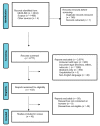Exploring the Utility of Autonomic Nervous System Evaluation for Stroke Prognosis
- PMID: 37218981
- PMCID: PMC10204362
- DOI: 10.3390/neurolint15020042
Exploring the Utility of Autonomic Nervous System Evaluation for Stroke Prognosis
Abstract
Stroke is a major cause of functional disability and is increasing in frequency. Therefore, stroke prognosis must be both accurate and timely. Among other biomarkers, heart rate variability (HRV) is investigated in terms of prognostic accuracy within stroke patients. The literature research of two databases (MEDLINE and Scopus) is performed to trace all relevant studies published within the last decade addressing the potential utility of HRV for stroke prognosis. Only the full-text articles published in English are included. In total, forty-five articles have been traced and are included in the present review. The prognostic value of biomarkers of autonomic dysfunction (AD) in terms of mortality, neurological deterioration, and functional outcome appears to be within the range of known clinical variables, highlighting their utility as prognostic tools. Moreover, they may provide additional information regarding poststroke infections, depression, and cardiac adverse events. AD biomarkers have demonstrated their utility not only in the setting of acute ischemic stroke but also in transient ischemic attack, intracerebral hemorrhage, and traumatic brain injury, thus representing a promising prognostic tool whose clinical application may greatly facilitate individualized stroke care.
Keywords: autonomic dysfunction; autonomic nervous system; heart rate variability; stroke outcome; stroke prognosis.
Conflict of interest statement
The authors declare no conflict of interest.
Figures
Similar articles
-
The Clinical Utility of Leukoaraiosis as a Prognostic Indicator in Ischemic Stroke Patients.Neurol Int. 2022 Nov 17;14(4):952-980. doi: 10.3390/neurolint14040076. Neurol Int. 2022. PMID: 36412698 Free PMC article. Review.
-
Copeptin Implementation on Stroke Prognosis.Neurol Int. 2023 Jan 16;15(1):83-99. doi: 10.3390/neurolint15010008. Neurol Int. 2023. PMID: 36648972 Free PMC article. Review.
-
Heart rate variability as an autonomic biomarker in ischemic stroke.Arq Neuropsiquiatr. 2020 Nov;78(11):724-732. doi: 10.1590/0004-282X20200087. Arq Neuropsiquiatr. 2020. PMID: 33331466 Review.
-
Leukoaraiosis as a Promising Biomarker of Stroke Recurrence among Stroke Survivors: A Systematic Review.Neurol Int. 2023 Aug 21;15(3):994-1013. doi: 10.3390/neurolint15030064. Neurol Int. 2023. PMID: 37606397 Free PMC article. Review.
-
Transcranial magnetic stimulation implementation on stroke prognosis.Neurol Sci. 2022 Feb;43(2):873-888. doi: 10.1007/s10072-021-05791-1. Epub 2021 Nov 30. Neurol Sci. 2022. PMID: 34846585 Review.
Cited by
-
Heart Rate Variability and Autonomic Dysfunction After Stroke: Prognostic Markers for Recovery.Biomedicines. 2025 Jul 7;13(7):1659. doi: 10.3390/biomedicines13071659. Biomedicines. 2025. PMID: 40722730 Free PMC article. Review.
-
Heart Rate Variability Applications in Medical Specialties: A Narrative Review.Appl Psychophysiol Biofeedback. 2025 Sep;50(3):359-381. doi: 10.1007/s10484-025-09708-y. Appl Psychophysiol Biofeedback. 2025. PMID: 40293647 Review.
-
A Comprehensive Review on the Role of Resting-State Functional Magnetic Resonance Imaging in Predicting Post-Stroke Motor and Sensory Outcomes.Neurol Int. 2024 Jan 19;16(1):189-201. doi: 10.3390/neurolint16010012. Neurol Int. 2024. PMID: 38392953 Free PMC article. Review.
-
The Effects of Autonomic Dysfunction on Functional Outcomes in Patients with Acute Stroke.Brain Sci. 2023 Dec 8;13(12):1694. doi: 10.3390/brainsci13121694. Brain Sci. 2023. PMID: 38137142 Free PMC article.
-
Predictive value of heart rate for prognosis in patients with cerebral infarction without atrial fibrillation comorbidity analyzed according to the MIMIC-IV database.Front Neurol. 2025 Mar 14;16:1551427. doi: 10.3389/fneur.2025.1551427. eCollection 2025. Front Neurol. 2025. PMID: 40162014 Free PMC article.
References
-
- Christidi F., Tsiptsios D., Fotiadou A., Kitmeridou S., Karatzetzou S., Tsamakis K., Sousanidou A., Psatha E.A., Karavasilis E., Seimenis I., et al. Diffusion Tensor Imaging as a Prognostic Tool for Recovery in Acute and Hyperacute Stroke. Neurol. Int. 2022;14:841–874. doi: 10.3390/neurolint14040069. - DOI - PMC - PubMed
-
- Christidi F., Tsiptsios D., Sousanidou A., Karamanidis S., Kitmeridou S., Karatzetzou S., Aitsidou S., Tsamakis K., Psatha E.A., Karavasilis E., et al. The Clinical Utility of Leukoaraiosis as a Prognostic Indicator in Ischemic Stroke Patients. Neurol. Int. 2022;14:952–980. doi: 10.3390/neurolint14040076. - DOI - PMC - PubMed
Publication types
Grants and funding
LinkOut - more resources
Full Text Sources



